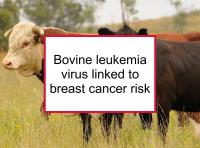Bovine leukemia virus (BLV) is a retrovirus which causes enzootic bovine leukosis in cattle. BLV affects the majority of U.S. beef and dairy cattle herds — one study estimated that 83% of dairy herds are infected. However, BLV typically does not cause obvious serious illness and the majority of infected animals are not culled from their herds.
The majority of people in the U.S. carry BLV antibodies in their blood, indicating exposure to the virus. Exposure to BLV has been proposed as contributing to breast cancer risk, although the findings are controversial. Now a new meta-analysis of previous studies has reported that BLV infection is associated with approximately 2.6 times the risk of breast cancer compared to no infection.
Breast cancer and BLV
BLV might persist for many years in breast tissue: relatively high levels of BLV have been found in both the benign breast tissue and breast tumors of the same women years later. BLV is more prevalent in the tumor specimens than in non-tumor breast tissues of the same women. One small study reported that BLV was identified in 91% of breast tumor specimens compared to only 35% of normal breast specimens.
Avoiding exposure to BLV
Beef labelled organic is not necessarily BLV-free. There is no efficient vaccine that can protect cattle against BLV infection. The majority of U.S. producers do not screen for BLV or actively try to reduce BLV incidence within their herds. However, heat and pasteurization destroy the virus. Therefore, raw milk and uncooked beef are the main possible sources of human BLV infection.
It is unclear to what extent handling raw beef during cooking (such as in making meatballs or preparing steak for grilling) could transmit the virus. However, it makes sense to use the same precautions in handling raw beef that are currently recommended for raw chicken. Tasting raw ground beef mixtures during cooking preparation or consuming beef "rare" or as steak tartare has the potential to introduce BLV infection.
Latest research finds link between BLV and breast cancer
The meta-analysis referenced above was designed to investigate the possible association between BLV exposure and breast cancer risk. To conduct the study, the authors identified relevant case-control studies in the PubMed, Google Scholar, Web of Science, Scopus, and EMBASE databases. A total of nine studies qualified for inclusion. Analysis of the combined data determined that BLV infection is associated with approximately 2.6 times the risk of breast cancer compared to no infection. The authors conclude that BLV infection is associated with increased risk of breast cancer. Control of the infection in cattle herds and screening of milk and dairy products might help to reduce the transmission of the virus to humans, according to the authors.
Please see our virus tag for more information.
